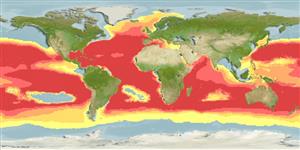Classification / Names
Common names from other countries
Main reference
Size / Weight / Age
Max length : 100.0 cm TL male/unsexed; (Ref. 26340)
Environment
Marine; pelagic-oceanic; depth range 1 - 140 m (Ref. 58302)
Climate / Range
Subtropical, preferred ?; 71°N - 55°S, 180°W - 180°E
Distribution
Cosmopolitan. Western Atlantic: Florida (USA), Martinique, Venezuela (Ref. 51183), and Brazil. Eastern Atlantic: Madeira to Scandinavia (Ref. 4711); Dakar, Senegambie, and Sierra Leone (Ref. 6952); South Africa. Eastern Pacific: central California, USA to Chile; rare north of Mexico (Ref. 2850). Indian Ocean: Madagascar (Ref. 33390), Mauritius (Ref. 58078), Reunion (Ref. 53568), Iran (Ref. 86583), Australia (49596). West Pacific: Japan (Ref. 559), China (Ref. 57879), Taiwan (Ref. 12711), New Zealand (Ref. 5755).
Countries | FAO areas | Ecosystems | Occurrences | Introductions
Short description
IUCN Red List Status (Ref. 115185)
Threat to humans
Harmless
Human uses
More information
ReferencesAquacultureAquaculture profileStrainsGeneticsAllele frequenciesHeritabilityDiseasesProcessingMass conversion
Tools
Special reports
Download XML
Internet sources
Estimates of some properties based on models
Phylogenetic diversity index
PD50 = 1.0625 many relatives (e.g. carps) 0.5 - 2.0 few relatives (e.g. lungfishes)
Trophic Level
3.7 ±0.47 se; Based on food items.
Resilience
Vulnerability
Moderate to high vulnerability (50 of 100)
Price category
